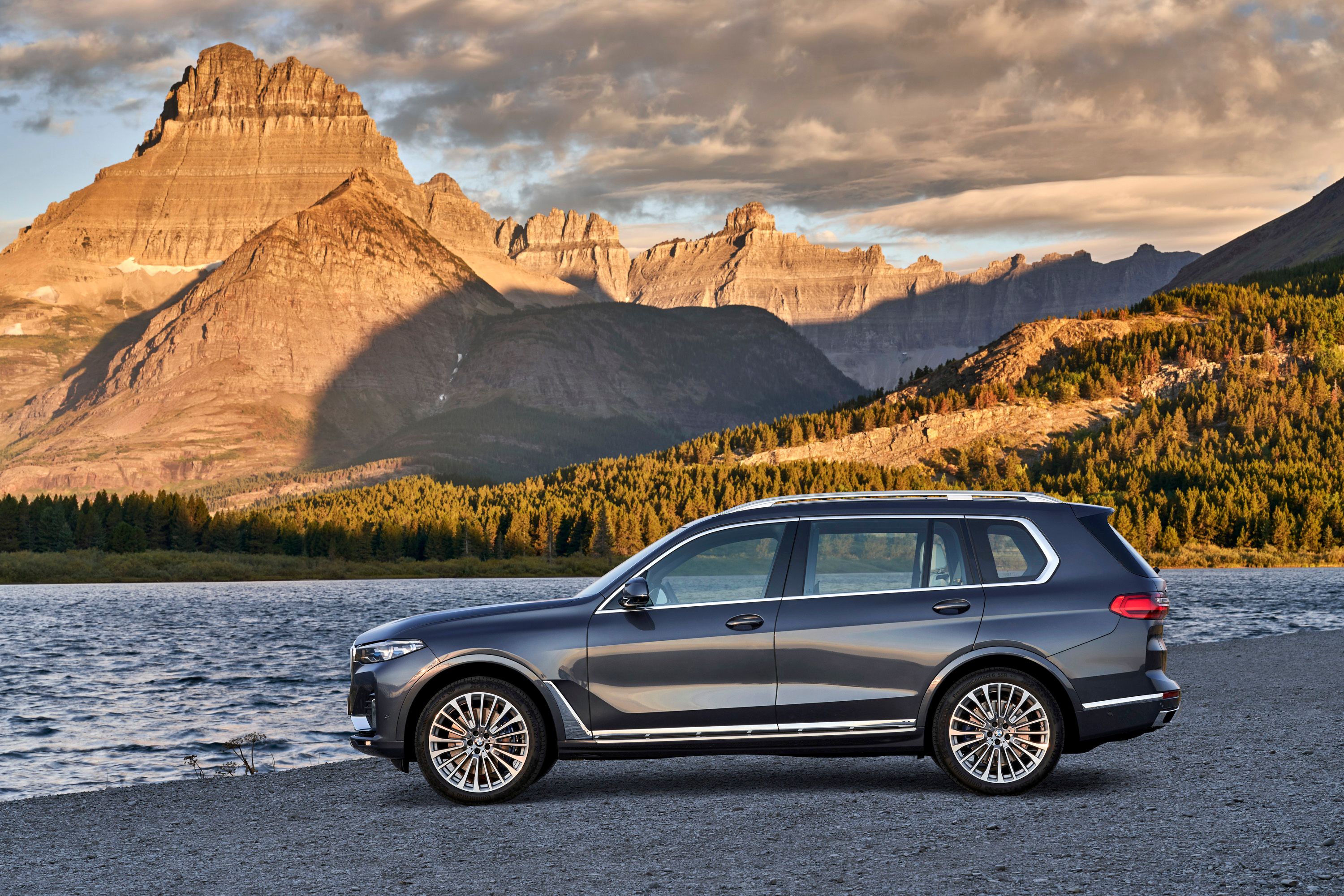The BMW X7 has arrived, and it’s poised to take the reigns from the X5 as Bavaria’s new flagship SUV. The full-sized behemoth will have its hands full competing against the likes of the Mercedes GLS-Class and the Land Rover Range Rover. For the time being, at least, the X7 will also draw comparisons to the model it’s replacing atop the BMW SUV food chain. Fair or not, the X7 will be compared to the X5, in part to judge the merits of the X7 as Bimmer’s new flagship SUV. The latter now holds the keys to BMW’s SUV kingdom as all eyes will be on it to see if it can elevate the German automaker’s status in the market.
Is the 2019 BMW X7 Just a Larger X5?
|
|
ids=800889,800888 |
no_overlay=true> |
On the surface, the BMW X7 looks larger than the BMW X5, but you’d be surprised that the latter isn’t that far off in the size department.
|
|
ids=800891,800890 |
no_overlay=true> |
Speaking of surprising, you can’t really tell the difference between the X7 and the X5 from the side unless you line them up side-by-side.
|
|
ids=800893,800892 |
no_overlay=true> |
In keeping with the theme that both these SUVs look more alike than they probably should, the rear section provides the latest evidence of that.
BMW X7 vs. BMW X5 exterior dimensions
|
BMW X7 |
BMW X5 |
|
|
Length inches |
203.3 |
193.77 |
|
Width inches |
78.7 |
78.89 |
|
Height inches |
71.1 |
68.7 |
|
Wheelbase inches |
122.2 |
117.1 |
Spot the Difference Inside if You Can
|
|
ids=800422,782564 |
no_overlay=true> |
The layout of the dashboard is startling, largely because they look about as identical as they can get. The instrument cluster and the infotainment system are mirror images of each other. The layout of the buttons in the center console is the same. Even the tunnels look like doppelgängers.
BMW X7 vs. BMW X5 interior dimensions
|
BMW X7 |
BMW X5 |
|
|
Shoulder width front inches |
60.0 |
60.0 |
|
Shoulder room 2nd row inches |
58.1 |
58.1 |
|
Shoulder room 3rd row Inches |
47.9 |
- |
|
Legroom front inches |
39.8 |
39.8 |
|
Legroom 2nd row inches |
37.6 |
37.4 |
|
Legroom 3rd row inches |
33.3 |
- |
|
Headroom front inches |
41.9 |
40.8 |
|
Headroom 2nd row inches |
39.9 |
38.7 |
|
Headroom 3rd row inches |
36.6 |
- |
|
Trunk volume (SAE) ft³ |
48.6 – 90.4 |
33.9-72.3 |
The 2019 BMW X5 is Faster than the 2019 BMW X7
Just like the BMW X5, the BMW X7 comes with a number of engine options, including a 3.0-liter turbocharged inline-six cylinder engine and a meatier 4.4-liter twin-turbo V-8 engine. The former produces 335 horsepower and 330 pound-feet of torque, good enough to help the X7 accelerate from 0 to 60 mph in 5.8 seconds.
Customers in Europe won’t get the V-8-powered X7, but in its place are a couple of diesel options, including a 3.0-liter inline-six diesel that produces 261 horsepower and 457 pound-feet of torque and a 3.0-liter quad-turbo diesel engine with 395 horsepower and 551 pound-feet of torque on tap.
The X5 boasts the same engine lineup, albeit tuned to produce different amounts of power. The 3.0-liter turbocharged inline-six cylinder, for example, surprisingly has slightly more power — 340 horsepower and 331 pound-feet of torque — than its X7 counterpart. That translates to the SUV’s acceleration time, too, as the X5 can sprint from 0 to 60 mph in 5.5 seconds, 0.3 seconds quicker than the X7. It’s the same story with the 4.4-liter twin-turbo V-8.
Diesel versions of the X5 are also available in Europe with the same engine lineup. The 3.0-liter inline-six produces 265 horsepower and 457 pound-feet of torque while the quad-turbo unit rolls out 400 ponies and 560 pound-feet of torque.
The performance times aren’t surprising considering that the X7 is bigger than the X5. But the big discrepancy is eyebrow-raising, as is the fact that, by all accounts, the X5 beats the X7 in the amount of power it can provide.
BMW X7 vs. BMW X5 specifications
|
BMW X7 xDr40i |
BMW X7 xDr50i |
BMW X5 xDr40i |
BMW X5 xDr50i |
|
|
Cylinders |
6 |
8 |
6 |
8 |
|
Valves per cylinder |
4 |
4 |
4 |
4 |
|
Displacement cm³ |
2,998 |
4,395 |
2,998 |
4,395 |
|
Engine power hp |
335 |
456 |
335 |
456 |
|
at rpm 1/min |
5,500 – 6,500 |
5,250 – 6,000 |
5,500 – 6,500 |
5,250 – 6,000 |
|
Engine torque ft. lbs. |
330 |
479 |
330 |
479 |
|
at rpm 1/min |
1,500 – 5,200 |
1,500 – 4,750 |
1,500 – 5,200 |
1,500 – 4,750 |
|
Curb weight lbs. |
5,370 |
5,617 |
4,813 |
5,170 |
|
0-60 mph seconds |
5.8 |
5.2 |
5.3 |
4.6 |
|
Top speed mph |
130 |
130 |
130 |
130 |
Food for thought
All of this isn’t going to take away from the new car smell of the BMW X7. Its debut as BMW’s new flagship SUV should be celebrated. It deserves its place in Bimmer’s SUV hierarchy, and it puts the X5 in a far more comfortable place itself. But it is surprising that BMW didn’t establish the X7 more emphatically. There are far too many similarities with the X5 that makes you wonder if the X7 even has its own identity.
Further reading
Read our full review on the 2019 BMW X7.
Read our full review on the 2019 BMW X5.

